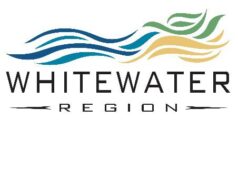by Connie Tabbert
Editor
COBDEN — Whitewater Region Township council and staff received a 40-minute history lesson on how planning began in Canada way back when.
One of the first history lessons learned was that Douglas had the first Registered Plan back in 1853, which was before Canada was established as a country.
That was just one of the facts Renfrew County planner Charles Cheesman provided during his Planning Orientation session to Whitewater council last Wednesday evening during a planning committee meeting.
It was in the 1800s when original surveys of townships, villages and towns were done by Crown surveyors, he said.
In 1846 two acts came into existence, the Registry Act and the Baldwin Act (also known as the Municipal Corporations Act). Seven years later, Douglas was Registered Plan 1.
In 1867, the British North America Act (BNA) was signed; in 1937 the Planning and Development Act came into play followed by the Planning Act in 1946.
Prior to 1970, when a lot was created, there was a detailed, written description of the land by a surveyor, Mr. Cheesman said.
Universal Subdivision Control applied to Ontario and these were the laws used in the creation of lots, he explained.
“The significant section of the Planning Act is Section 50, Subsection Three of the Planning Act which basically prohibits the transfer of land for 20 years or more unless the owner is dealing with the whole of the parcel and not part of it,” Mr. Cheesman stated.
Explaining, he said a person can sell the whole parcel, but if selling only a portion, permission is needed through a severance or plan of subdivision, he added.
Whenever there is a property transaction in Ontario, Section 50, Subsection Three comes into effect, he said. This ensures the buyer is purchasing a whole parcel of land, not a portion, he said.
The goals of subdivision control are basically the same today as many years ago, Mr. Cheesman said. When lots are created, the planner wanted to know the boundaries, appropriate lot sizes and access to the lots as well as any issues around municipal servicing.
Mr. Cheesman noted prior to the depression, municipalities put in municipal services. However, when the depression struck, it was the taxpayer stuck paying off the bill because municipalities had no money to pay the bill.
Now when a subdivision is being constructed, the developer pays to have the municipal services installed, which is not a cost to all taxpayers, he explained.
He also noted subdivision in the early years meant a sub-dividing of land because when original township lots were created in the 1800s, they were the original divisions of land and anything after that was considered a subdivision of township lots.
In June 1970, the County Land Division committee was introduced followed by the establishment of the Renfrew County Land Division Committee a year later.
In 1973, the Ontario Economic Council released the Subject to Approval — A Review of Municipal Planning in Ontario and four years later the Comay Report was released, which was the Report of the Planning Act Review committee.
In the early 1980s and 1990s, the provincial government began getting into planning and the first Provincial Policy Statements (PPS) were created, Mr. Cheesman said. Every new provincial government would change the statement which affected such things as floodplains, mineral aggregate, wetlands, planning for housing, etc.
On April 15, 1991, the Ministry of Municipal Affairs and Housing released Review of Severance and Zoning bylaws in Grey County, Mr. Cheesman said.
“This was an interesting period in the history because the (NDP) government came into power and they felt the county wasn’t doing a proper job with its severances and zonings and they came down and took their power away temporarily until things got settled,” he said. “I don’t think it’s ever happened since then, but it was an interesting time.”
On June 6, 1991, the province appointed three people to the Commission on Planning and Development Reform in Ontario, he said.
“The NDP government of the day wanted to review the whole planning function in Ontario and appointed John Sewell and two commissioners and they went around the province listening to people,” he said.
The County met with the commission with about 30 to 40 people to voice their opinions.
Two years later, the Sewell Commission issued its final report Planning for Ontario and there were “a whole lot of things in there,” Mr. Cheesman said.
All provincial policies should be in one document and should apply to all decision makers, not just the provincial government; decisions made by land division committees and councils on zoning bylaws and amendments shall be consistent with provincial policies and reviewed every five years, he explained. There was also the stipulation there shall be five year reviews of official plans, which the county is now undertaking of its official plan, Mr. Cheesman said.
The Ministry of Municipal Affairs released the Comprehensive Set of Provincial Policy Statements and Implementation Guidelines in 1994.
On June 8, 1994, Mike Harris was elected to power and the planning process was reviewed and the wording in the Provincial Policy Statement replaced shall be consistent with to shall have regard to…
On May 22, 1996, the Common Sense Revolution began, which included downloads and amalgamations.
On Oct. 2, 2003, Dalton McGuinty and his Liberals were elected to power and two years later the PPS was changed back to “Shall be consistent with.”
The final change of the PPS occurred on April 30, 2014.
Mr. Cheesman also provided an explanation of what is planning.
“It’s the orderly arrangement of land, resources, facilities and services with a view to securing the physical, economic and social efficiency, health and well-being of urban and rural communities,” he said. “The goal of land-use planning is to further the welfare of people and their communities by creating convenience, equitable, healthy, efficient and attractive environments for present and future generations.”
In layman’s terms, it’s how you use the land, how you develop the land, how it economically benefits the community and how it leads to better places for people to live in, Mr. Cheesman said.
The provincial role in planning is to provide legislation, approving amendments to County of Renfrew Official Plan, comments on consent applications and providing land use data, he said.
The hierarchy of planning documents shows that the provincial legislation is at the top of the list followed by provincial policies, county/municipal plans and local municipal implementation, he said.
The Planning Act promotes sustainable economic development in a healthy, natural environment, he said. It provides a land use planning system led by provincial policy, integrates matters of provincial interest in planning decisions, provides fair, open accessible, timely and efficient planning process; provides co-operation and co-ordination among various interests and recognizes the decision-making authority and accountability of municipal councils in planning, Mr. Cheesman stated.
“When you make a decision and there’s an appeal to the Ontario Municipal Board, the Board is supposed to take into consideration what the municipal council initially made in its decision,” he said. “It doesn’t necessarily mean it will agree with you.”
The development of land involves a lot of interest from various parties, including property owners, municipal governments and various agencies, to work together to ensure there is good planning.
The PPS provides policy direction on matters of provincial interest related to land use planning and development, he said. This means any decision made has to be consistent with the current policy statement, he explained.
There are three headings in the PPS, Mr. Cheesman said. They are: Building Strong Communities; Wise Use and Management of Resources and Protecting Public Health and Safety.
The official plan sets out council’s policies on how land should be used, he said.
“It is prepared with input from the community and public agencies and helps to ensure that future planning and development will meet the specific needs of the community,” Mr. Cheesman stated.
When Whitewater’s building official Doug Schultz reviews a file, he must ensure the polices are consistent with the PPS.
The zoning bylaw establishes specific zones for all properties with the aim of ensuring compatibility between land uses, he said.
“It divides land into different zones, commercial, residential, industrial,” Mr. Cheesman said. “The zones are based on capability of uses and it’s devised to maintain the character of city and residential areas and protect them from the intrusion of uses that may not be compatible.”
The zoning bylaw implements policies of the official plan by setting out specific, permitted uses, setbacks, heights, parking, etc. through the use of specific zone provisions and general provisions, he added.
To make it easier to understand, Mr. Cheesman said the official plan applies to council and the zoning bylaw applies to properties.
The types of planning applications are official plan amendment, zoning bylaw amendment, minor variance, plan of subdivisions, consent and site plan.
Milestones for planning in the county include the creation of the planning department in 1975 and three years later the first local comprehensive zoning bylaw was passed. In 1979 the first local official plan was approved in the county. In 1988, there were 26 local official plans zoning bylaws, although there were 36 municipalities.
On March 26, 1997, county staff approved straight forward consents, which disputed files of land division committee.
On July 1, 1997, the first amalgamation in Renfrew County occurred, which was the Town of Petawawa, created from the former township and village of Petawawa.
In the late 1990, the county’s Geographic Information System was designed.
A major event happened in Renfrew County in 2000 and 2001, when several municipalities amalgamated. The number of municipalities went down to 17 from 36.
In 2003, the first County of Renfrew Official Plan was approved by the Ministry of Municipal Affairs and Housing.
The county’s official plan was designed to replace local plans in smaller/rural areas and local zoning bylaws would implement the plan. Ten local municipalities use the county official plan, including Whitewater Township, and seven towns have their own local OPs.
The county plan is a combination of local and provincial policies, he said. It incorporates specific policies for municipalities as requested.
Mr. Cheesman said there are several benefits of having a county official plan, he said. Some include: allowing the county to speak in one voice; taxpayer dollars are saved with one plan instead of several smaller ones; there is a flexible severance policy; streamlines policies and the county plan qualifies as a sustainable community, which means it’s eligible for gas tax revenue.
The County of Renfrew Official Plan is reviewed every five years, which is currently happening, Mr. Cheesman said.
For the past nine years, Whitewater Region Township has been working on Official Plan Amendment #11 to respond to development restrictions on Muskrat Lake and to encourage growth in the township, he said. It was the culmination of a major policy review started by previous councils, he said. There were numerous meetings, including public, with a committee formed by the previous council.
“What came out at the end of that process was an amendment to our County of Renfrew Official Plan,” he said.
Last summer, the county adopted the amendment and it’s now awaiting approval by the Ministry of Municipal Affairs and Housing.
Mr. Cheesman also reviewed the role of County of Renfrew Planning and the planner, he said.
The role of Whitewater Region Township in all of this is to accept and process planning applications, provide notices to the public and agencies, hold public meetings, make recommendations and decisions that are consistent with the PPS, provide notices of decision and provide recommendations to the county.
If the township and county disagree with a decision, it will go to the land division committee, he said.
The public’s role in planning is they are the proponents of development, can be objectors and appellants, provide input on planning issues and they are a source of local knowledge, he said.
The zoning bylaw review is now underway, which incorporates bylaws from the former municipalities of Ross, Westmeath, Cobden and site specific bylaws for the former village of Beachburg, he said.
“It’s currently a real mix of a dog’s breakfast,” he said. “It’s not in anybody’s interest to have these old documents. They’re old and out of date and there is no consistency between them.
“It’s an important job to bring them together,” he added.
Mr. Cheesman and junior planner Anne McVean, who was also at the session, are preparing the zoning bylaw and will bring it to council for review. There are many documents, but when they are together instead of a mish-mash, they will be up-to-date policies, he added.
Over the last 20 to 25 years, zoning amendment exceptions were granted, totalling about 300, and Ms. McVean has to go through all of them and map and chart them to ensure they are included in the new zoning bylaw, he explained.
As for when it will be completed, Mr. Cheesman had no commitment, but was hopeful for this year.
Ending his session, Mr. Cheesman noted there is a balancing act between public and private interests.
Mayor Hal Johnson said he is glad to see that there will be one umbrella for the zoning bylaws.
“It’s key to future development if we can get one plan,” he said.







![Kenopic/Smith Auction [Paid Ad]](https://whitewaternews.ca/wp-content/uploads/2018/10/advertising-100x75.jpeg)

